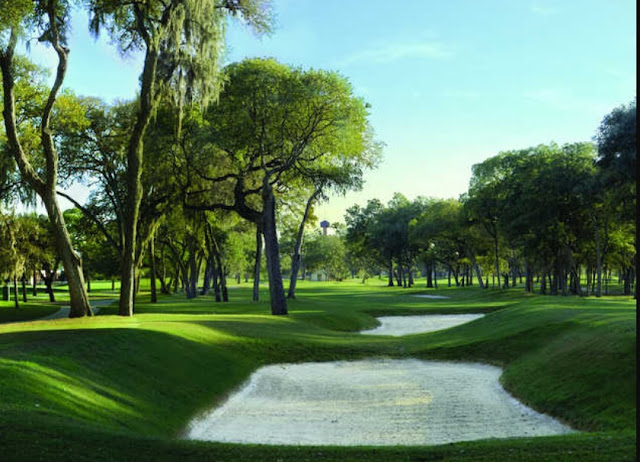(The beautiful Brackenridge clubhouse.)
The city of San Antonio had the good sense to restore Brackenridge, and even tho eminent domain robbed the back nine of some really great holes, the front was a grand success. Using old photographs, the geometric shaped bunkers, tees, and greens were brought back to life.
The most interesting feature are the square greens. There are seven of them and the linear edge emphasizes the need to hit a quality shot. Typically, there is no catching a piece of the green.
(The seventh hole has a rectangular green. The rear portion has a mound that intrudes from the left, making back pin placements difficult to attack.)
(The par three eighth has three bunkers set into the base of the ridge several yards short of the green.)
The front nine starts off with a short par four. Then the second is a long par three with double bunkers guarding the front, forcing players to carry the ball all the way to the putting surface. The third is a a good par five. Cross bunkers put pressure on the layup, and the green is surrounded by sands, placing pressure on all three shots. A couple well placed ridges makes birdie a tough proposition.
(The bunkers have flat bottoms and grass faces. Can you imagine your ball nestling on the slope?)
The fourth has a bunker thirty yards short of the green. It completely hides the putting surface and the player has to gauge his shot by trusting the yardage. I like how the sixth green is directly behind, making this one of the more intimate spots on the course. Players have a view of the action of several other holes too. The sixth has a square green divided by a ridge, the high point being the center of the green. The seventh green is rectangular but the rear portion is near a mound which influences putts or chips hit from front to back.
The eighth is a strong par three, then nine is a reachable par five, one of the true birdie opportunities on the course. The front nine is a wonderful example of old architecture. It's super fun to play!
The back nine lost the most when they put in the freeway, but the restoration cleaned up the creek, and made it a good water hazard once again for the holes where it guards the green.
(Twelve is a par five that uses the creek. It is reachable in two, but poor drives will have to layup to the water.)
(The short par three fifteenth begins an unremarkable finish to Brackenridge. These four holes took the brunt of the eminent domain.)
The twelfth and fourteenth are the two holes the creek fronts. Twelve is a par five so it's only in play if you're trying to reach it in two, but fourteen is a long two shotter so the tee shot is very important.
The last four holes fizzle out with a short (yawn) uphill par three, a very weird driving hole par four, a driveable par four (for the longest hitter), and a good ending par three over water.
(The final hole is a good par three over water. The green is square shaped with a sand trap front right and water fronting. The live oaks and clubhouse make for a beautiful setting.)
For golf purists, Brackenridge is a great place to play. I didn't get that feeling in my stomach like I did at Pasatiempo, but I was pretty excited to see my first Tillinghast course! The back nine hurts it's rating but I still give it a 5 (good). It's a definitive must play if you find yourself in San Antonio. Or at least a must visit to the Texas Hall of Fame.










































